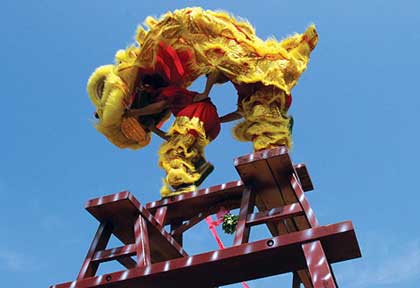Source: chinaculture.org
01-17-2008 17:36
 |
Performing lion dances during the Spring Festival while paying New Year calls has been a long tradition in Guilin, Guangxi Autonomous Region. It is the most spectacular event in Guilin in this festival season, believed to bring good luck to the households or businesses which they visit.
The lion is enacted by two dancers. One handles the head, made out of strong but light materials like paper-cloth and bamboo, while the other plays the body and the tail under a cloth that is attached to the head. The "lion" is accompanied by some musicians, playing a large drum, cymbals and a gong. Tow other masked dancers in the front teases it with a fan or a giant ball. To give life to the lion, the head dancer can move the lion's eyes, mouth and ears for expression of moods.
The lion dance combines art, history and kungfu moves. Normally the performers are kungfu practitioners. Each move has a specific musical rhythm. The music follows the moves of the lion: the drum follows the lion, and the cymbals and the gong follow the drum player. The use of firecrackers, drums, gongs and cymbals are related to the role of the lion in dispelling evil and bringing good luck.
The dramatic climax of the lion dance is the Cai Qing or "Picking the Green". The green here refers to vegetable leaves which are tied to a piece of string attached with a red packet containing money. The string is hung above the door of the house or business, and the lion "eats" both leaves and the red packet. Lying on the floor the leaves are "chewed" by the lion while the musicians play a dramatic rolling crescendo. The lull is broken as the lion explodes back into activity while spitting out the leaves. This is a symbolic act of blessing by the lion, with the spitting out of the leaves signifying that there will be an abundance of everything in the coming year.
Editor:Liu Fang
